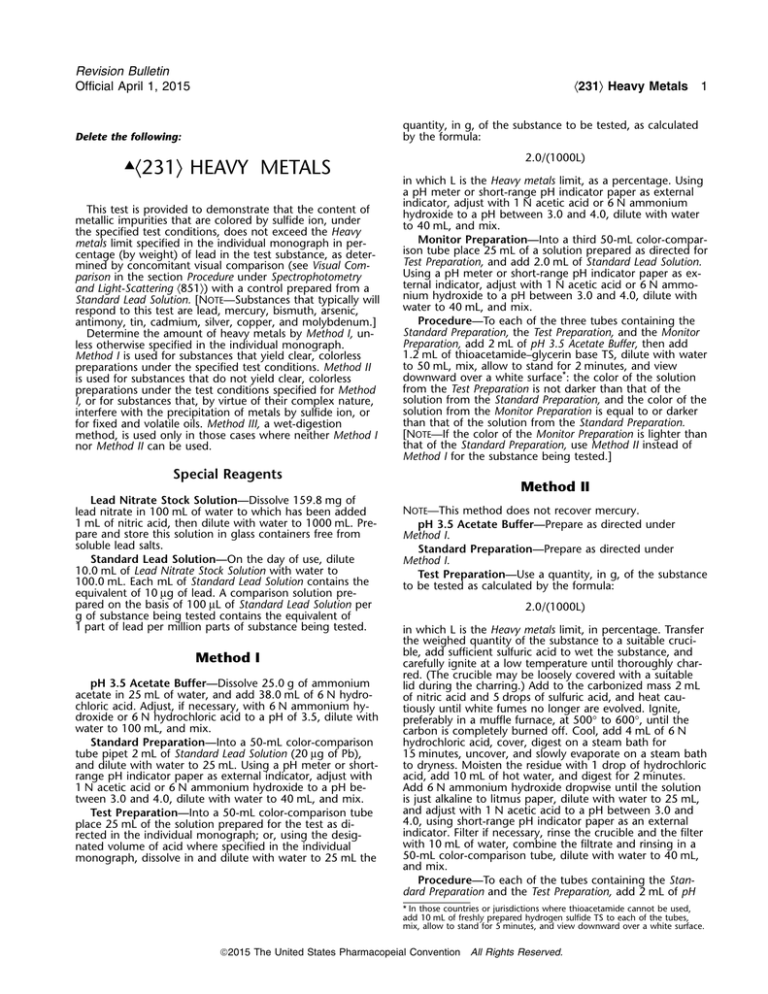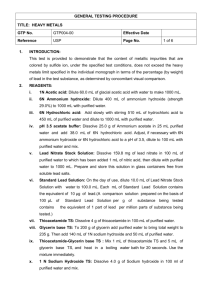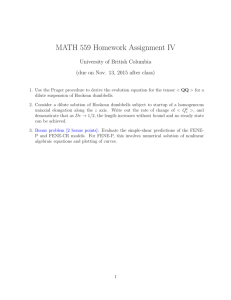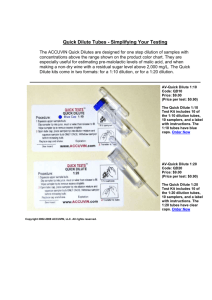
Revision Bulletin
Official April 1, 2015
⟨231⟩ Heavy Metals 1
quantity, in g, of the substance to be tested, as calculated
by the formula:
Delete the following:
⟨231⟩ HEAVY METALS
▲
This test is provided to demonstrate that the content of
metallic impurities that are colored by sulfide ion, under
the specified test conditions, does not exceed the Heavy
metals limit specified in the individual monograph in percentage (by weight) of lead in the test substance, as determined by concomitant visual comparison (see Visual Comparison in the section Procedure under Spectrophotometry
and Light-Scattering ⟨851⟩) with a control prepared from a
Standard Lead Solution. [NOTE—Substances that typically will
respond to this test are lead, mercury, bismuth, arsenic,
antimony, tin, cadmium, silver, copper, and molybdenum.]
Determine the amount of heavy metals by Method I, unless otherwise specified in the individual monograph.
Method I is used for substances that yield clear, colorless
preparations under the specified test conditions. Method II
is used for substances that do not yield clear, colorless
preparations under the test conditions specified for Method
I, or for substances that, by virtue of their complex nature,
interfere with the precipitation of metals by sulfide ion, or
for fixed and volatile oils. Method III, a wet-digestion
method, is used only in those cases where neither Method I
nor Method II can be used.
Special Reagents
Lead Nitrate Stock Solution—Dissolve 159.8 mg of
lead nitrate in 100 mL of water to which has been added
1 mL of nitric acid, then dilute with water to 1000 mL. Prepare and store this solution in glass containers free from
soluble lead salts.
Standard Lead Solution—On the day of use, dilute
10.0 mL of Lead Nitrate Stock Solution with water to
100.0 mL. Each mL of Standard Lead Solution contains the
equivalent of 10 µg of lead. A comparison solution prepared on the basis of 100 µL of Standard Lead Solution per
g of substance being tested contains the equivalent of
1 part of lead per million parts of substance being tested.
Method I
pH 3.5 Acetate Buffer—Dissolve 25.0 g of ammonium
acetate in 25 mL of water, and add 38.0 mL of 6 N hydrochloric acid. Adjust, if necessary, with 6 N ammonium hydroxide or 6 N hydrochloric acid to a pH of 3.5, dilute with
water to 100 mL, and mix.
Standard Preparation—Into a 50-mL color-comparison
tube pipet 2 mL of Standard Lead Solution (20 µg of Pb),
and dilute with water to 25 mL. Using a pH meter or shortrange pH indicator paper as external indicator, adjust with
1 N acetic acid or 6 N ammonium hydroxide to a pH between 3.0 and 4.0, dilute with water to 40 mL, and mix.
Test Preparation—Into a 50-mL color-comparison tube
place 25 mL of the solution prepared for the test as directed in the individual monograph; or, using the designated volume of acid where specified in the individual
monograph, dissolve in and dilute with water to 25 mL the
2.0/(1000L)
in which L is the Heavy metals limit, as a percentage. Using
a pH meter or short-range pH indicator paper as external
indicator, adjust with 1 N acetic acid or 6 N ammonium
hydroxide to a pH between 3.0 and 4.0, dilute with water
to 40 mL, and mix.
Monitor Preparation—Into a third 50-mL color-comparison tube place 25 mL of a solution prepared as directed for
Test Preparation, and add 2.0 mL of Standard Lead Solution.
Using a pH meter or short-range pH indicator paper as external indicator, adjust with 1 N acetic acid or 6 N ammonium hydroxide to a pH between 3.0 and 4.0, dilute with
water to 40 mL, and mix.
Procedure—To each of the three tubes containing the
Standard Preparation, the Test Preparation, and the Monitor
Preparation, add 2 mL of pH 3.5 Acetate Buffer, then add
1.2 mL of thioacetamide–glycerin base TS, dilute with water
to 50 mL, mix, allow to stand for 2 minutes, and view
downward over a white surface*: the color of the solution
from the Test Preparation is not darker than that of the
solution from the Standard Preparation, and the color of the
solution from the Monitor Preparation is equal to or darker
than that of the solution from the Standard Preparation.
[NOTE—If the color of the Monitor Preparation is lighter than
that of the Standard Preparation, use Method II instead of
Method I for the substance being tested.]
Method II
NOTE—This method does not recover mercury.
pH 3.5 Acetate Buffer—Prepare as directed under
Method I.
Standard Preparation—Prepare as directed under
Method I.
Test Preparation—Use a quantity, in g, of the substance
to be tested as calculated by the formula:
2.0/(1000L)
in which L is the Heavy metals limit, in percentage. Transfer
the weighed quantity of the substance to a suitable crucible, add sufficient sulfuric acid to wet the substance, and
carefully ignite at a low temperature until thoroughly charred. (The crucible may be loosely covered with a suitable
lid during the charring.) Add to the carbonized mass 2 mL
of nitric acid and 5 drops of sulfuric acid, and heat cautiously until white fumes no longer are evolved. Ignite,
preferably in a muffle furnace, at 500° to 600°, until the
carbon is completely burned off. Cool, add 4 mL of 6 N
hydrochloric acid, cover, digest on a steam bath for
15 minutes, uncover, and slowly evaporate on a steam bath
to dryness. Moisten the residue with 1 drop of hydrochloric
acid, add 10 mL of hot water, and digest for 2 minutes.
Add 6 N ammonium hydroxide dropwise until the solution
is just alkaline to litmus paper, dilute with water to 25 mL,
and adjust with 1 N acetic acid to a pH between 3.0 and
4.0, using short-range pH indicator paper as an external
indicator. Filter if necessary, rinse the crucible and the filter
with 10 mL of water, combine the filtrate and rinsing in a
50-mL color-comparison tube, dilute with water to 40 mL,
and mix.
Procedure—To each of the tubes containing the Standard Preparation and the Test Preparation, add 2 mL of pH
* In those countries or jurisdictions where thioacetamide cannot be used,
add 10 mL of freshly prepared hydrogen sulfide TS to each of the tubes,
mix, allow to stand for 5 minutes, and view downward over a white surface.
2015 The United States Pharmacopeial Convention All Rights Reserved.
2
Revision Bulletin
Official April 1, 2015
⟨231⟩ Heavy Metals
3.5 Acetate Buffer, then add 1.2 mL of
thioacetamide–glycerin base TS, dilute with water to 50 mL,
mix, allow to stand for 2 minutes, and view downward over
a white surface*: the color of the solution from the Test
Preparation is not darker than that of the solution from the
Standard Preparation.
Method III
pH 3.5 Acetate Buffer—Prepare as directed under
Method I.
Standard Preparation—Transfer a mixture of 8 mL of
sulfuric acid and 10 mL of nitric acid to a clean, dry,
100-mL Kjeldahl flask, and add a further volume of nitric
acid equal to the incremental volume of nitric acid added
to the Test Preparation. Heat the solution to the production
of dense, white fumes; cool; cautiously add 10 mL of water;
and, if hydrogen peroxide was used in treating the Test
Preparation, add a volume of 30 percent hydrogen peroxide
equal to that used for the substance being tested. Boil gently to the production of dense, white fumes. Again cool,
cautiously add 5 mL of water, mix, and boil gently to the
production of dense, white fumes and to a volume of 2 to
3 mL. Cool, dilute cautiously with a few mL of water, add
2.0 mL of Standard Lead Solution (20 µg of Pb), and mix.
Transfer to a 50-mL color-comparison tube, rinse the flask
with water, adding the rinsing to the tube until the volume
is 25 mL, and mix.
Test Preparation—Unless otherwise indicated in the individual monograph, use a quantity, in g, of the substance
to be tested as calculated by the formula:
2.0/(1000L)
in which L is the Heavy metals limit, as a percentage.
If the substance is a solid—Transfer the weighed quantity
of the test substance to a clean, dry, 100-mL Kjeldahl flask.
[NOTE—A 300-mL flask may be used if the reaction foams
excessively.] Clamp the flask at an angle of 45°, and add a
sufficient quantity of a mixture of 8 mL of sulfuric acid and
10 mL of nitric acid to moisten the substance thoroughly.
Warm gently until the reaction commences, allow the reaction to subside, and add portions of the same acid mixture,
heating after each addition, until a total of 18 mL of the
acid mixture has been added. Increase the amount of heat,
and boil gently until the solution darkens. Cool, add 2 mL
of nitric acid, and heat again until the solution darkens.
Continue the heating, followed by addition of nitric acid
until no further darkening occurs, then heat strongly to the
production of dense, white fumes. Cool, cautiously add
5 mL of water, boil gently to the production of dense,
white fumes, and continue heating until the volume is reduced to a few mL. Cool, cautiously add 5 mL of water,
and examine the color of the solution. If the color is yellow,
cautiously add 1 mL of 30 percent hydrogen peroxide, and
again evaporate to the production of dense, white fumes
and a volume of 2 to 3 mL. If the solution is still yellow,
repeat the addition of 5 mL of water and the peroxide
treatment. Cool, dilute cautiously with a few mL of water,
and rinse into a 50-mL color-comparison tube, taking care
that the combined volume does not exceed 25 mL.
If the substance is a liquid—Transfer the weighed quantity of the test substance to a clean, dry, 100-mL Kjeldahl
flask. [NOTE—A 300-mL flask may be used if the reaction
foams excessively.] Clamp the flask at an angle of 45°, and
cautiously add a few mL of a mixture of 8 mL of sulfuric
acid and 10 mL of nitric acid. Warm gently until the reaction commences, allow the reaction to subside, and proceed as directed for If the substance is a solid, beginning
with “add portions of the same acid mixture.”
Monitor Preparation—Proceed with the digestion, using the same amount of sample and the same procedure as
directed in the subsection If the substance is a solid in the
section Test Preparation, until the step “Cool, dilute cautiously with a few mL of water.” Add 2.0 mL of Lead Standard Solution (20 µg of lead), and mix. Transfer to a 50-mL
color comparison tube, rinse the flask with water, adding
the rinsing to the tube until the volume is 25 mL, and mix.
Procedure—Treat the Test Preparation, the Standard
Preparation, and the Monitor Preparation as follows. Using a
pH meter or short-range pH indicator paper as external indicator, adjust the solution to a pH between 3.0 and 4.0
with ammonium hydroxide (a dilute ammonia solution may
be used, if desired, as the specified range is approached),
dilute with water to 40 mL, and mix.
To each tube add 2 mL of pH 3.5 Acetate Buffer, then add
1.2 mL of thioacetamide–glycerin base TS, dilute with water
to 50 mL, mix, allow to stand for 2 minutes, and view
downward over a white surface*: the color of the Test Preparation is not darker than that of the Standard Preparation,
and the color of the Monitor Preparation is equal to or
darker than that of the Standard Preparation.
Official: December 1, 2015
•Official: January 1, 2018• (RB 1-Apr-2015)
▲USP38
2015 The United States Pharmacopeial Convention All Rights Reserved.





